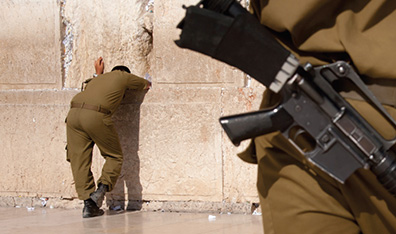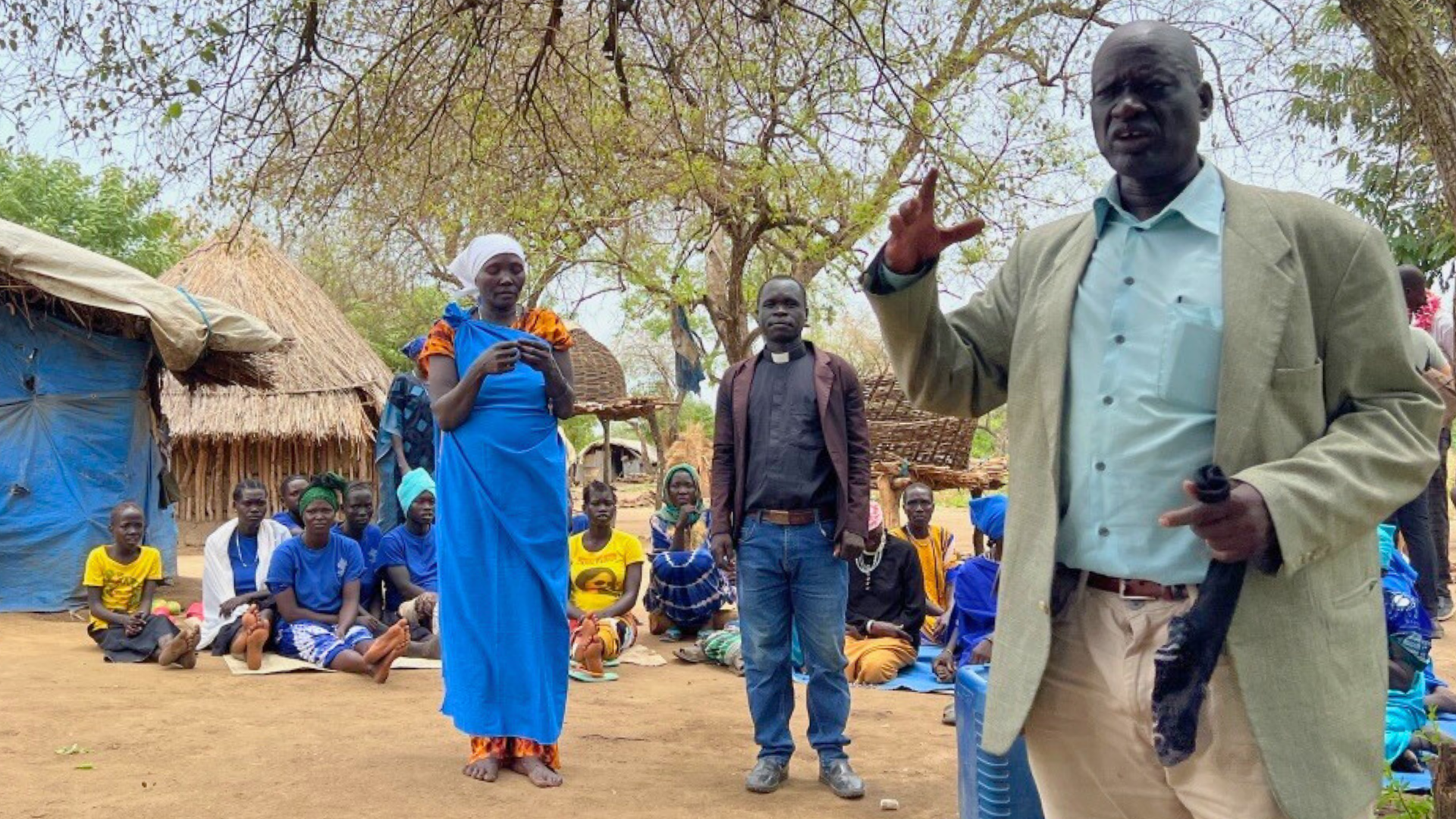Steve Norman is the lead pastor of the Troy, Michigan, campus of Kensington Church an independent congregation. He blogs at stevenorman.org.
[divider type=”dotted”]
What does it mean to take the angels’ Christmas proclamation seriously?
I’m not a huge fan of Christmas cards. Don’t get me wrong. I’m all for any effort to reconnect with family and old friends over the holidays, reflecting on the spirit of Advent with the people we love. It’s the cards themselves I find frustrating. Soothing pastoral landscapes with quasi-scriptural platitudes seem to cheapen the majesty of the season, threatening to strip it of the awe it deserves.
There’s no shortage of commentary on the commercialization of Christmas and the quest to rediscover its true meaning. And I’m not looking to add to the pile. But this year I’ve been haunted by a phrase from the nativity account in Luke’s Gospel that’s been hijacked by Hallmark: “peace on earth.” Maybe it’s time to steal it back.
 I’ve read and heard these words every Christmas for as long as I can remember. But it hasn’t been until recently that they challenged me to view the incarnation with fresh eyes. Luke 2 says, “Suddenly a great company of the heavenly host appeared with the angel, praising God and saying, ‘Glory to God in the highest heaven, and on earth peace to those on whom his favor rests’” (Luke 2:13-14, TNIV).
I’ve read and heard these words every Christmas for as long as I can remember. But it hasn’t been until recently that they challenged me to view the incarnation with fresh eyes. Luke 2 says, “Suddenly a great company of the heavenly host appeared with the angel, praising God and saying, ‘Glory to God in the highest heaven, and on earth peace to those on whom his favor rests’” (Luke 2:13-14, TNIV).
And on earth—peace. Peace on earth. World peace. Peace in our time. These feel like the words of starry-eyed children, naïve beauty pageant contestants, and freshman diplomats. A concept with the potential to be truly transformational is reduced to trite and mundane clichés. Of course no one would discount the value of this promise. It’s just that no one I know believes it’s coming anytime soon. In the face of daily horrific accounts of violence from different corners of the globe, peace seems elusive, and those who call for it often appear to have at least one foot in fantasyland.
Recently I traveled to Israel and the West Bank, and I struggled to acclimate to the sight of the seemingly omnipresent machine guns. On airport security guards, on an army reservist praying at Jerusalem’s famed Western Wall, slung over the shoulder of a young woman in shorts ordering a hamburger on the road to Jericho. Their presence was a constant reminder of the region’s history of violence and ever-present threat of explosive incidents. To be fair, this part of the Middle East isn’t the only region in the world experiencing a peace vacuum, but it may be the most famous.
And while the current conflict touching the gently sloping hills of Bethlehem is a modern one, the town is no stranger to war and conquest. Israel, located at the intersection of three continents, was historically viewed as prime real estate for expanding empires. As a result, it seemed to be in a perennial state of occupation. When the Christ child finally arrived, it was the Romans who had set up shop in the Holy Land. The Gospels include numerous references to the Roman occupation, various mentions of Roman rulers, military officers (centurions), soldiers, and means of dealing with criminals so as to maintain law and order (crucifixion).
That Joseph and a very pregnant Mary had to travel from Nazareth to Bethlehem at all is further evidence that the Jewish people weren’t in control of their own destiny. In some cases Rome’s presence was merely an inconvenience; in others it threatened the identity and aspirations of the Jewish people. When the heavenly chorale announced this “peace on earth,” it was to a people longing for freedom, safety, and self-determination.
So when an army of angels proclaimed good news that first Christmas, I’m sure that ragtag group of shocked shepherds heard that declaration of peace quite differently than we do. To those living in the shadow of conflict, the idea of peace evokes a visceral reaction. For them, it was exponentially more than some flowery sentiment; it was a laying of great fears to rest, igniting long dead hopes for freedom.
But as exciting as their sprint to the manger and the events that immediately followed must have been, that peace for which they had been yearning failed to materialize. Herod’s massacre of male children in their hometown was a brutal indicator of their broken world; maybe, they wondered, the angels got their wires crossed.
Thirty years would pass before the baby would become a man, a rabbi with a message of his own. During that time the tension in Judea never resolved. The Romans believed peace came through displays of strength, while many Jews were convinced their land wouldn’t know peace until the Romans were expelled.
And Jesus comes into this setting announcing a new kingdom, a reality that shattered his hearers’ categories of both victor and villain. Matthew’s Gospel says Jesus’s handpicked band of followers includes “Matthew the tax collector; James son of Alphaeus, and Thaddaeus; Simon the Zealot” (Matthew 10:3-4, TNIV). At first glance, the list feels ordinary—something to be read with the same passion required of a genealogy.
But Jesus’s choices for his inner circle expose his fierce commitment to build bridges between warring factions and to reconcile the most bitter rivals. Simon is a Zealot, part of a potentially militant sect in the region seeking to overthrow the Romans. And seated at the same table is Matthew, who in his role as tax collector is his neighborhood’s face of the hated occupation. So Jesus selected both a representative of the occupation (a collaborator) and a representative of its fiercest opposition. We can only imagine what kinds of heated conversations Matthew and Simon the Zealot must have had as they walked through Galilee with Jesus.
Maybe they were both present on the day Jesus spoke these bold words: “Blessed are the pure in heart, for they will see God. Blessed are the peacemakers, for they will be called children of God. Blessed are those who are persecuted because of righteousness, for theirs is the kingdom of heaven” (Matthew 5:8-10, TNIV). Here Jesus associates peacemaking with concepts like purity of heart and the kind of courage that comes with putting yourself in harm’s way for refusing to deny your faith. Not only does he unmistakably identify peacemaking as an integral value of this new kingdom he’s announcing, but he also associates it with blessing, a state of joy and fulfillment. In elevating the importance of announcing peace, he notes that it is akin to aligning oneself with the family of God. The ultimate condition for being a child of God, then, is not lineage, but rather active participation in what God is already doing in the midst of the world’s great conflicts.
Yet as important as peacemaking was for Jesus, it tends not be a central issue or practice in many churches. Recently I surveyed several hundred U.S. churches on how they view mission. Randomly selected evangelical church leaders were asked: “What are the most important components of global mission for you personally?” And then, “What activities is your congregation most committed to at this time?”
Perhaps not surprisingly, areas like personal evangelism, church leadership development, church planting, medical care, and disaster relief topped the list. Peacemaking, on the other hand, tended to be at or near the bottom for both questions. I won’t speculate here as to the underlying causes of this mind-set. Suffice it say, most people don’t know where or how to engage in the peacemaking process. Although I’ve spent the past few years studying this concept, I can’t claim to know either.
What I am certain of, however, is that it’s an issue I need to struggle with, reflect on, and press into. For me specifically, I’m invested in exploring what it should look like for U.S. Christians to be a voice of hope and peace in the midst of the Israeli-Palestinian crisis. The more I learn, the more I find amazing people committed to peacemaking in the face of some harrowing obstacles. And for reasons I still don’t fully understand, I’m actively looking for ways I, and our church, can get involved. It’s been an exhilarating, confusing, and often frustrating journey.
For most of my adult life I’ve confused “peacemaking” with “harmony seeking.” But I don’t think the angels came with such great fanfare to advocate “playing well with others.”
Seeking peace often gets confused as an argument for weakness, putting “peacemaker” in the realm of one who avoids conflict by deferring, encouraging compliance, or just keeping quiet. It’s easy to view peacemaking as the act of pursuing superficial cooperation between differing parties without ever getting to core issues. But it’s not. He says, “Blessed are the peacemakers.” Not the pacifists, not conflict avoiders, not the appeasers.
My concordance tells me the Greek word for maker has the same root as the words doer and producer. So Jesus’s declaration could read, “Joyful are the peace-doers, the peace-producers, the reconciliation-makers.” It’s a verse that grabs you when you’re faced with impossible conflict—like the conflict the church in modern-day Bethlehem understands all too well.
If Jesus’s birth in that ancient city brought with it the promise of peace and healing, then his death and resurrection announce the means by which that becomes possible. Peace is not an abstract, but in the words of my friend Abdu Murray, a Lebanese American author, Christmas reminds us that “peace is a person.”
The Apostle Paul puts it this way: “For he himself is our peace, who has made the two one and has destroyed the barrier, the dividing wall of hostility, by setting aside in his flesh the law with its commands and regulations. His purpose was to create in himself one new humanity out of the two, thus making peace, and in one body to reconcile both of them to God through the cross, by which he put to death their hostility. He came and preached peace to you who were far away and peace to those who were near. For through him we both have access to the Father by one Spirit” (Ephesians 2:14-18, TNIV).
In Jesus’s economy, peace between sparring tribes and nations is not ultimately the result of accords, summits, and negotiations—it’s the product of a new humanity, which, because it has been reconciled to God, can finally be reconciled to the other. This is at the core of biblical peacemaking: offering new lenses to peoples in conflict, equipping them with a chance to see themselves in the other, to witness the basic humanity in the ones they’ve been so quick to demonize. And over time, as I heard one urban pastor say, “Prejudice dies with exposure.” The church has a unique role to play in creating safe environments in which individuals with a history of hostility can enter into the pain, dreams, and aspirations of their enemy. In doing so, they begin to see themselves.
This is where things get complicated. When I consider the heartbreak and uncertainty experienced by those in the West Bank and Israel, I pray for opportunities to be a voice of hope there. Yet lately I’ve come to realize there is no shortage of conflict and unrest in my own personal relationships. Why is it that I’m eager to work for peace on a grand scale but quick to overlook it at the micro level? Clearly, it’s easier to referee someone else’s conflict overseas than it is to be candid about my own. But to pursue the former without addressing the latter is an exercise in hypocrisy. This bold peace unfurled at Christ’s birth wasn’t just for faraway hostilities, nor is it just on offer for me to be reconciled to God. It is peace, a shalom, a wholeness for every situation where peace is lacking, made possible by God’s incredible grace and favor.
Listen. Hear it again: “Glory to God in the highest! Peace on earth to those on whom his favor rests.” Heaven rejoiced with the arrival of peace incarnate to an oppressed people. It rejoices still in the truth that the reconciliation the Christ Child came to bring is now possible: reconciliation in our broken family dynamics, our strained friendships and trying marriages; reconciliation between antagonistic nations and ethnicities and reconciliation, between a rebellious humanity and its Creator.
No, Christmas is not a celebration that all is right with the world. Rather, it is a pronouncement that the kingdom of peace has taken a beachhead in a crooked world. It points to hope now and a future, final resolution for every human conflict, a day when the holy infant returns as victorious king. When he does, “he will judge between the nations and will settle disputes for many peoples.
They will beat their swords into plowshares and their spears into pruning hooks. Nation will not take up sword against nation, nor will they train for war anymore” (Isaiah 2:4, TNIV). What a beautiful, compelling image. If only I could find someone to put it on a Christmas card.














